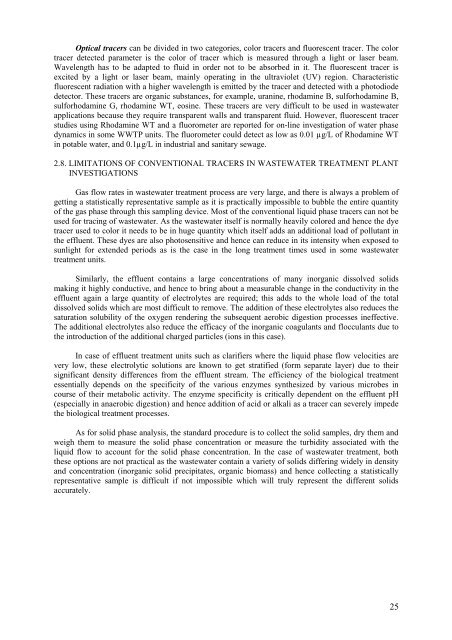Download file - Ayuntamiento de Zaragoza
Download file - Ayuntamiento de Zaragoza
Download file - Ayuntamiento de Zaragoza
Create successful ePaper yourself
Turn your PDF publications into a flip-book with our unique Google optimized e-Paper software.
Optical tracers can be divi<strong>de</strong>d in two categories, color tracers and fluorescent tracer. The colortracer <strong>de</strong>tected parameter is the color of tracer which is measured through a light or laser beam.Wavelength has to be adapted to fluid in or<strong>de</strong>r not to be absorbed in it. The fluorescent tracer isexcited by a light or laser beam, mainly operating in the ultraviolet (UV) region. Characteristicfluorescent radiation with a higher wavelength is emitted by the tracer and <strong>de</strong>tected with a photodio<strong>de</strong><strong>de</strong>tector. These tracers are organic substances, for example, uranine, rhodamine B, sulforhodamine B,sulforhodamine G, rhodamine WT, eosine. These tracers are very difficult to be used in wastewaterapplications because they require transparent walls and transparent fluid. However, fluorescent tracerstudies using Rhodamine WT and a fluorometer are reported for on-line investigation of water phasedynamics in some WWTP units. The fluorometer could <strong>de</strong>tect as low as 0.01 µg/L of Rhodamine WTin potable water, and 0.1µg/L in industrial and sanitary sewage.2.8. LIMITATIONS OF CONVENTIONAL TRACERS IN WASTEWATER TREATMENT PLANTINVESTIGATIONSGas flow rates in wastewater treatment process are very large, and there is always a problem ofgetting a statistically representative sample as it is practically impossible to bubble the entire quantityof the gas phase through this sampling <strong>de</strong>vice. Most of the conventional liquid phase tracers can not beused for tracing of wastewater. As the wastewater itself is normally heavily colored and hence the dyetracer used to color it needs to be in huge quantity which itself adds an additional load of pollutant inthe effluent. These dyes are also photosensitive and hence can reduce in its intensity when exposed tosunlight for exten<strong>de</strong>d periods as is the case in the long treatment times used in some wastewatertreatment units.Similarly, the effluent contains a large concentrations of many inorganic dissolved solidsmaking it highly conductive, and hence to bring about a measurable change in the conductivity in theeffluent again a large quantity of electrolytes are required; this adds to the whole load of the totaldissolved solids which are most difficult to remove. The addition of these electrolytes also reduces thesaturation solubility of the oxygen ren<strong>de</strong>ring the subsequent aerobic digestion processes ineffective.The additional electrolytes also reduce the efficacy of the inorganic coagulants and flocculants due tothe introduction of the additional charged particles (ions in this case).In case of effluent treatment units such as clarifiers where the liquid phase flow velocities arevery low, these electrolytic solutions are known to get stratified (form separate layer) due to theirsignificant <strong>de</strong>nsity differences from the effluent stream. The efficiency of the biological treatmentessentially <strong>de</strong>pends on the specificity of the various enzymes synthesized by various microbes incourse of their metabolic activity. The enzyme specificity is critically <strong>de</strong>pen<strong>de</strong>nt on the effluent pH(especially in anaerobic digestion) and hence addition of acid or alkali as a tracer can severely impe<strong>de</strong>the biological treatment processes.As for solid phase analysis, the standard procedure is to collect the solid samples, dry them andweigh them to measure the solid phase concentration or measure the turbidity associated with theliquid flow to account for the solid phase concentration. In the case of wastewater treatment, boththese options are not practical as the wastewater contain a variety of solids differing wi<strong>de</strong>ly in <strong>de</strong>nsityand concentration (inorganic solid precipitates, organic biomass) and hence collecting a statisticallyrepresentative sample is difficult if not impossible which will truly represent the different solidsaccurately.25
















